battery Lancia Ypsilon 2011 Owner handbook (in English)
[x] Cancel search | Manufacturer: LANCIA, Model Year: 2011, Model line: Ypsilon, Model: Lancia Ypsilon 2011Pages: 299, PDF Size: 13.35 MB
Page 159 of 299
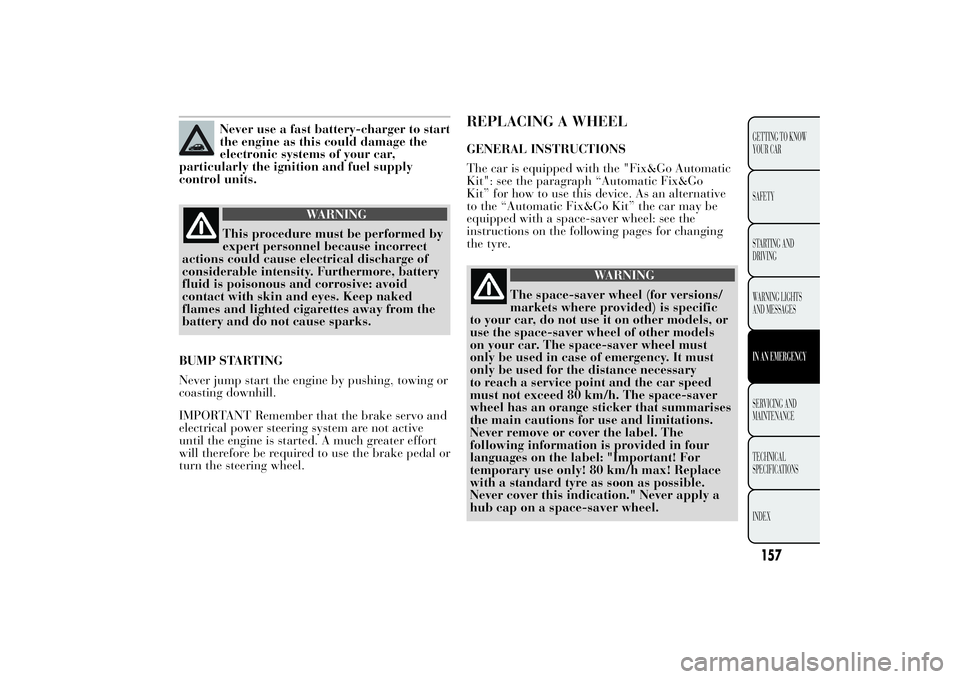
Never use a fast battery-charger to start
the engine as this could damage the
electronic systems of your car,
particularly the ignition and fuel supply
control units.
WARNING
This procedure must be performed by
expert personnel because
incorrect
actions could cause electrical discharge of
considerable intensity. Furthermore, battery
fluid is poisonous and corrosive: avoid
contact with skin and eyes. Keep naked
flames and lighted cigarettes away from the
battery and do not cause sparks.
BUMP STARTING
Never jump start the engine by pushing, towing or
coasting downhill.
IMPORTANT Remember that the brake servo and
electrical power steering system are not active
until the engine is started. A much greater effort
will therefore be required to use the brake pedal or
turn the steering wheel.
REPLACING A WHEELGENERAL INSTRUCTIONS
The car is equipped with the "Fix&Go Automatic
Kit": see the paragraph “Automatic Fix&Go
Kit” for how to use this device. As an alternative
to the “Automatic Fix&Go Kit” the car may be
equipped with a space-saver wheel: see the
instructions on the following pages for changing
the tyre.
WARNING
The space-saver wheel (for versions/
markets where provided)
is specific
to your car, do not use it on other models, or
use the space-saver wheel of other models
on your car. The space-saver wheel must
only be used in case of emergency. It must
only be used for the distance necessary
to reach a service point and the car speed
must not exceed 80 km/h. The space-saver
wheel has an orange sticker that summarises
the main cautions for use and limitations.
Never remove or cover the label. The
following information is provided in four
languages on the label: "Important! For
temporary use only! 80 km/h max! Replace
with a standard tyre as soon as possible.
Never cover this indication." Never apply a
hub cap on a space-saver wheel.
157GETTING TO KNOW
YOUR CAR
SAFETY
STARTING AND
DRIVING
WARNING LIGHTS
AND MESSAGESIN AN EMERGENCYSERVICING AND
MAINTENANCE
TECHNICAL
SPECIFICA
TIONS
INDEX
Page 185 of 299

FUSE LOCATION
Engine compartment fuse box
This is located next to the battery: to access fuses
proceed as follows:
❒move the cover A fig. 148 aside;
❒undo the screw A fig. 149, free the tabs B and
pull the cover upwards C. The ID number of
the electrical component corresponding to each
fuse can be found on the back of the cover.
After replacing the fuse, make sure that you
have closed cover C correctly on the fuse box.
If you need to wash the engine
compartment, take care not to directly
hit the fuse box and the window wiper
motors with the water jet.
fig. 148
L0F0170
fig. 149
L0F0094
183GETTING TO KNOW
YOUR CAR
SAFETY
STARTING AND
DRIVING
WARNING LIGHTS
AND MESSAGESIN AN EMERGENCYSERVICING AND
MAINTENANCE
TECHNICAL
SPECIFICA
TIONS
INDEX
Page 191 of 299

Engine compartment fuse box FUSE AMPS
Heated rear window/mirror defrosters F20 30
Air conditioning compressor F21 7,5
Supply from SCM main relay for ECU
F22 15
Supply from SCM main relay for ECM
F22 10
BSM 9.0 (ECU, valves) F23 20
BSM 9.0/NGE (+15 INT) F24 7,5
Heater plug control unit (versions 1.3 16V MultiJet) F81 60
Passenger compartment fan F82 40
Front power socket (with or without cigar lighter) F85 15
Battery charge status sensor F87 5+15 = ignition-operated positive terminal
+30 = battery direct positive terminal (not
ignition-operated)
189GETTING TO KNOW
YOUR CAR
SAFETY
STARTING AND
DRIVING
WARNING LIGHTS
AND MESSAGESIN AN EMERGENCYSERVICING AND
MAINTENANCE
TECHNICAL
SPECIFICA
TIONS
INDEX
(versions 1.2 8V 69 HP) (versions 0.9 TwinAir 85 HP/1.3 16V MultiJet)
Page 192 of 299

Dashboard fuse box FUSE AMPS
Free F12 -
+ 15 headlamp alignment corrector and IPC
F13 5
+ 15 INT/A F31 5
Free F32 -
+30 KL30 F36 10
+15 switch on brake pedal (NO) F37 7,5
Door central locking F38 20
Two-way windscreen washer pump F43 20
Front electric window (driver side) F47 20
Front electric window (passenger side) F48 20
+ 15 KL15 F49 7,5
+ 15 KL15 F50 7,5
+ 15 KL15 F51 5
+30 KL30 F53 7,5+15 = ignition-operated positive terminal
+30 = battery direct positive terminal (not
ignition-operated)
190
GETTING TO KNOW
YOUR CAR
SAFETY
STARTING AND
DRIVING
WARNING LIGHTS
AND MESSAGESIN AN EMERGENCYSERVICING AND
MAINTENANCE
TECHNICAL
SPECIFICA
TIONS
INDEX
headlamp levelling
Page 194 of 299

BATTERY RECHARGINGIMPORTANT The battery recharging procedure is
given as information only. You are advised to go
to a Lancia Dealership to have this operation
performed.
Low amperage slow recharging for approximately
24 hours is advised. Charging for a longer time
may damage the battery.
VERSIONS WITHOUT Start&Stop SYSTEM
(for versions/markets, where provided)
Charge the battery as follows:
❒disconnect the negative battery terminal;
❒connect the charger cables to the battery
terminals, observing the polarity;
❒turn on the charger;
❒when finished, turn the charger off before
disconnecting the battery;
❒reconnect the negative battery terminal.VERSIONS WITH Start&Stop SYSTEM
(for versions/markets, where provided)
Charge the battery as follows:
❒disconnect the connector A fig. 155 (pressing
the button B) from the sensor C monitoring
the battery conditions, on the negative pole D of
the battery;
❒connect the positive cable of the battery charger
to the positive battery terminal E and the
negative cable to sensor terminal D as shown;
❒turn on the battery charger. At the end of the
charging process, switch the battery charger off;
192
GETTING TO KNOW
YOUR CAR
SAFETY
STARTING AND
DRIVING
WARNING LIGHTS
AND MESSAGESIN AN EMERGENCYSERVICING AND
MAINTENANCE
TECHNICAL
SPECIFICA
TIONS
INDEX
❒after having disconnected the battery charger,
reconnect connector A fig. 155 to the sensor C
as shown.
Page 195 of 299

IMPORTANT If the car is equipped with an alarm
system, this has to be disabled using the remote
control (see "Alarm" paragraph in "Knowing your
car").
WARNING
Battery fluid is poisonous and
corrosive: avoid contact
with your
skin and eyes. The battery should be
charged in a well ventilated place, away
from naked flames or possible sources of
sparks: danger of explosion and fire.
WARNING
Do not attempt to charge a frozen
battery: it must
be thawed first,
otherwise it may explode. If freezing has
occurred, the battery should be checked by
skilled personnel to make sure that the
internal elements are not damaged and that
the body is not cracked, with the risk of
leaking poisonous and corrosive acid.
fig. 155
L0F0229
193GETTING TO KNOW
YOUR CAR
SAFETY
STARTING AND
DRIVING
WARNING LIGHTS
AND MESSAGESIN AN EMERGENCYSERVICING AND
MAINTENANCE
TECHNICAL
SPECIFICA
TIONS
INDEX
Page 200 of 299
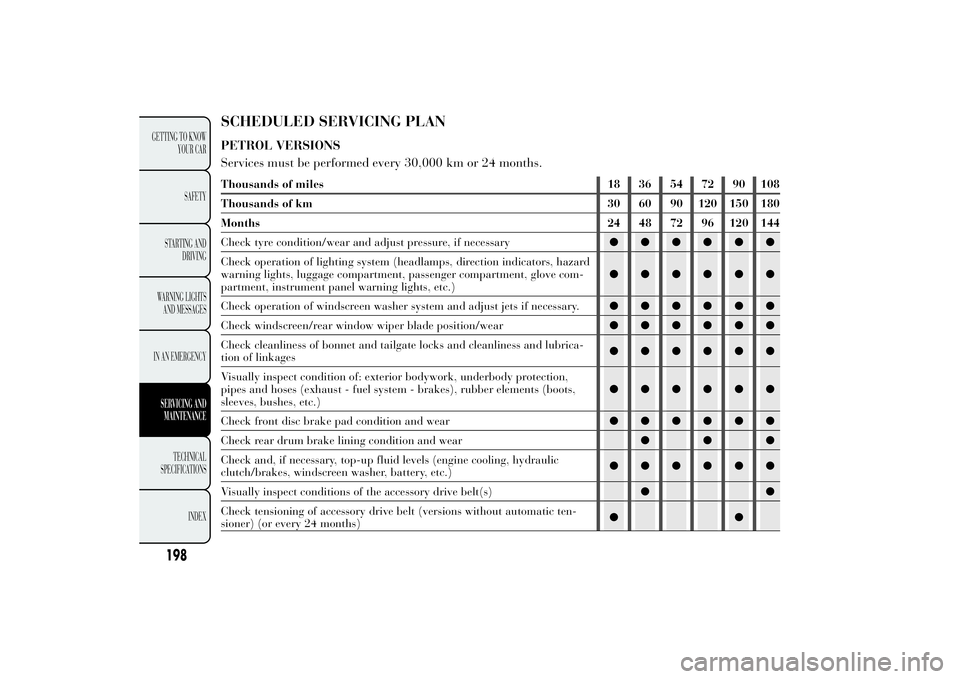
SCHEDULED SERVICING PLANPETROL VERSIONS
Services must be performed every 30,000 km or 24 months.Thousands of miles 18 36 54 72 90 108
Thousands of km 30 60 90 120 150 180
Months 24 48 72 96 120 144
Check tyre condition/wear and adjust pressure, if necessary●●●●●●
Check operation of lighting system (headlamps, direction indicators, hazard
warning lights, luggage compartment, passenger compartment, glove com-
partment, instrument panel warning lights, etc.)●●●●●●
Check operation of windscreen washer system and adjust jets if necessary.●●●●●●
Check windscreen/rear window wiper blade position/wear●●●●●●
Check cleanliness of bonnet and tailgate locks and cleanliness and lubrica-
tion of linkages●●●●●●
Visually inspect condition of: exterior bodywork, underbody protection,
pipes and hoses (exhaust - fuel system - brakes), rubber elements (boots,
sleeves, bushes, etc.)●●●●●●
Check front disc brake pad condition and wear●●●●●●
Check rear drum brake lining condition and wear●●●
Check and, if necessary, top-up fluid levels (engine cooling, hydraulic
clutch/brakes, windscreen washer, battery, etc.)●●●●●●
Visually inspect conditions of the accessory drive belt(s)●●
Check tensioning of accessory drive belt (versions without automatic ten-
sioner) (or every 24 months)●●
198
GETTING TO KNOW
YOUR CAR
SAFETY
STARTING AND
DRIVING
WARNING LIGHTS
AND MESSAGES
IN AN EMERGENCYSERVICING AND
MAINTENANCE
TECHNICAL
SPECIFICA
TIONS
INDEX
Page 201 of 299
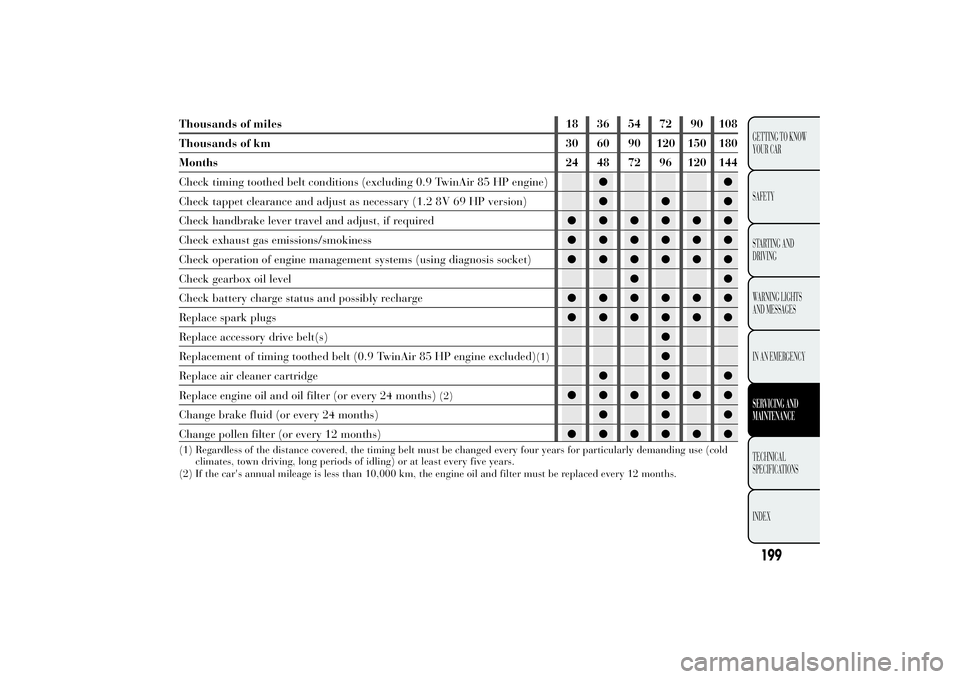
Thousands of miles 18 36 54 72 90 108
Thousands of km 30 60 90 120 150 180
Months 24 48 72 96 120 144
Check timing toothed belt conditions (excluding 0.9 TwinAir 85 HP engine)●●
Check tappet clearance and adjust as necessary (1.2 8V 69 HP version)●●●
Check handbrake lever travel and adjust, if required●●●●●●
Check exhaust gas emissions/smokiness●●●●●●
Check operation of engine management systems (using diagnosis socket)●●●●●●
Check gearbox oil level●●
Check battery charge status and possibly recharge●●●●●●
Replace spark plugs●●●●●●
Replace accessory drive belt(s)●
Replacement of timing toothed belt (0.9 TwinAir 85 HP engine excluded)
(1)
●
Replace air cleaner cartridge●●●
Replace engine oil and oil filter (or every 24 months)
(2)
●●●●●●
Change brake fluid (or every 24 months)●●●
Change pollen filter (or every 12 months)●●●●●●
(1) Regardless of the distance covered, the timing belt must be changed every four years for particularly demanding use (cold
climates, town driving, long periods of idling) or at least every five years.
(2) If the car's annual mileage is less than 10,000 km, the engine oil and filter must be replaced every 12 months.
199GETTING TO KNOW
YOUR CAR
SAFETY
STARTING AND
DRIVING
WARNING LIGHTS
AND MESSAGES
IN AN EMERGENCYSERVICING AND
MAINTENANCETECHNICAL
SPECIFICA
TIONS
INDEX
Page 202 of 299
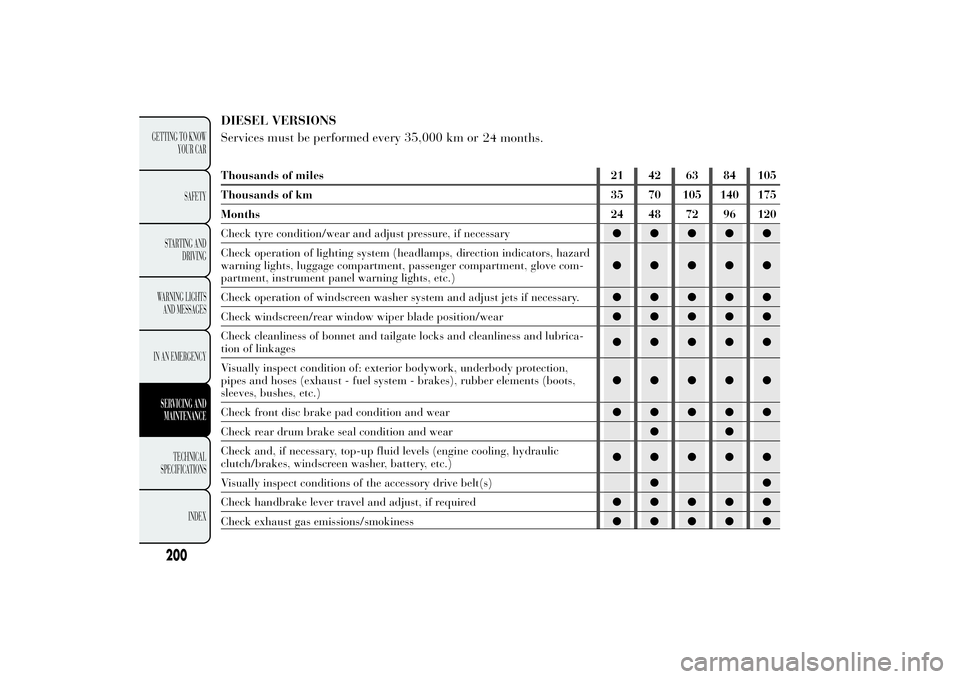
DIESEL VERSIONS
Services must be performed every 35,000 km or
24 months.Thousands of miles 21 42 63 84 105
Thousands of km 35 70 105 140 175
Months 24 48 72 96 120
Check tyre condition/wear and adjust pressure, if necessary●●●●●
Check operation of lighting system (headlamps, direction indicators, hazard
warning lights, luggage compartment, passenger compartment, glove com-
partment, instrument panel warning lights, etc.)●●●●●
Check operation of windscreen washer system and adjust jets if necessary.●●●●●
Check windscreen/rear window wiper blade position/wear●●●●●
Check cleanliness of bonnet and tailgate locks and cleanliness and lubrica-
tion of linkages●●●●●
Visually inspect condition of: exterior bodywork, underbody protection,
pipes and hoses (exhaust - fuel system - brakes), rubber elements (boots,
sleeves, bushes, etc.)●●●●●
Check front disc brake pad condition and wear●●●●●
Check rear drum brake seal condition and wear●●
Check and, if necessary, top-up fluid levels (engine cooling, hydraulic
clutch/brakes, windscreen washer, battery, etc.)●●●●●
Visually inspect conditions of the accessory drive belt(s)●●
Check handbrake lever travel and adjust, if required●●●●●
Check exhaust gas emissions/smokiness●●●●●
200
GETTING TO KNOW
YOUR CAR
SAFETY
STARTING AND
DRIVING
WARNING LIGHTS
AND MESSAGES
IN AN EMERGENCYSERVICING AND
MAINTENANCE
TECHNICAL
SPECIFICA
TIONS
INDEX
Page 203 of 299
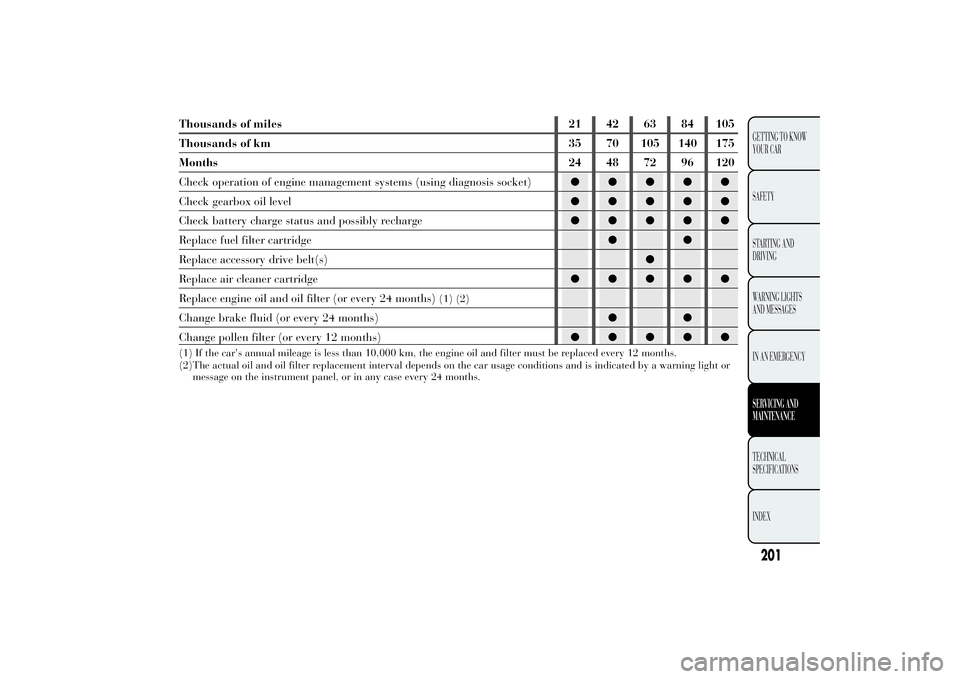
Thousands of miles 21 42 63 84 105
Thousands of km 35 70 105 140 175
Months 24 48 72 96 120
Check operation of engine management systems (using diagnosis socket)●●●●●
Check gearbox oil level●●●●●
Check battery charge status and possibly recharge●●●●●
Replace fuel filter cartridge●●
Replace accessory drive belt(s)●
Replace air cleaner cartridge●●●●●
Replace engine oil and oil filter (or every 24 months)
(1) (2)
Change brake fluid (or every 24 months)●●
Change pollen filter (or every 12 months)●●●●●(1) If the car's annual mileage is less than 10,000 km, the engine oil and filter must be replaced every 12 months.
(2)The actual oil and oil filter replacement interval depends on the car usage conditions and is indicated by a warning light or
message on the instrument panel, or in any case every 24 months.
201GETTING TO KNOW
YOUR CAR
SAFETY
STARTING AND
DRIVING
WARNING LIGHTS
AND MESSAGES
IN AN EMERGENCYSERVICING AND
MAINTENANCETECHNICAL
SPECIFICA
TIONS
INDEX